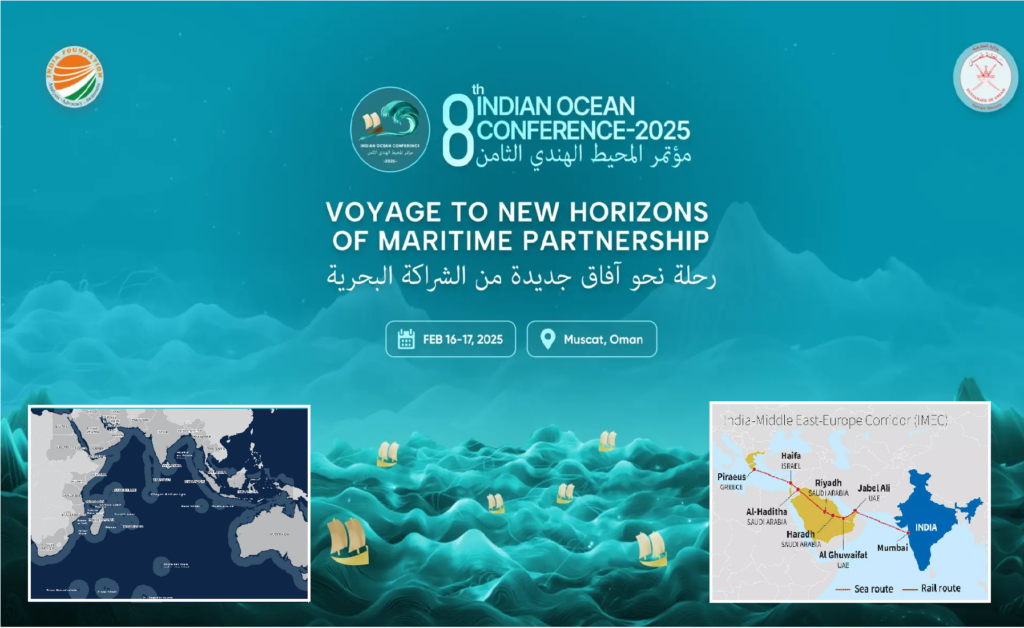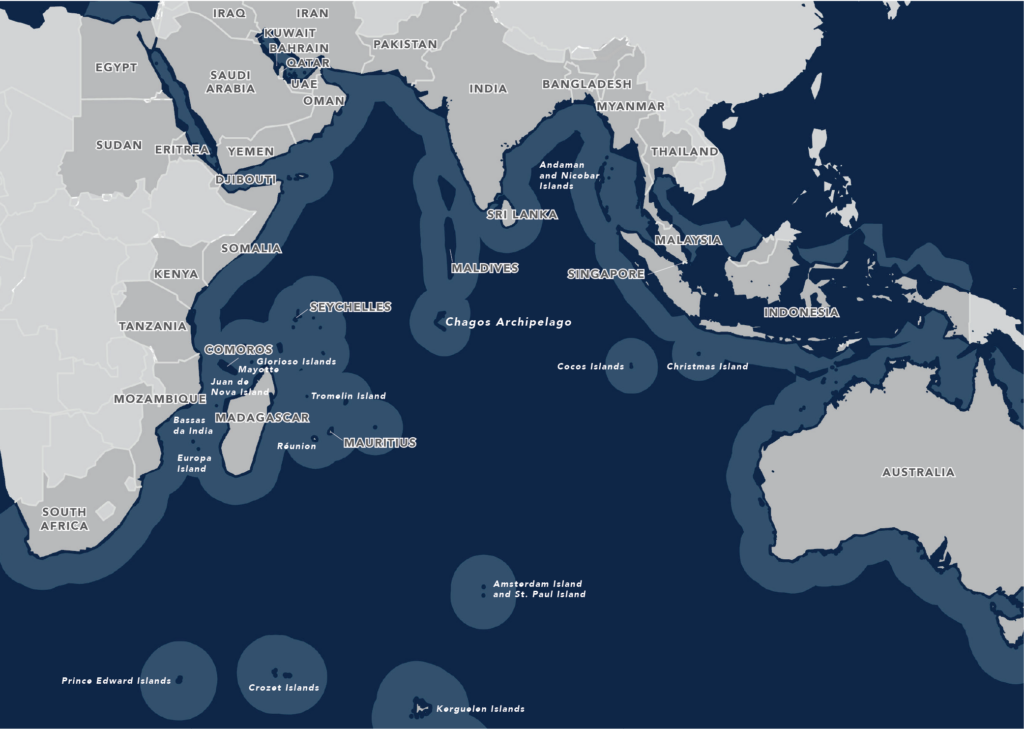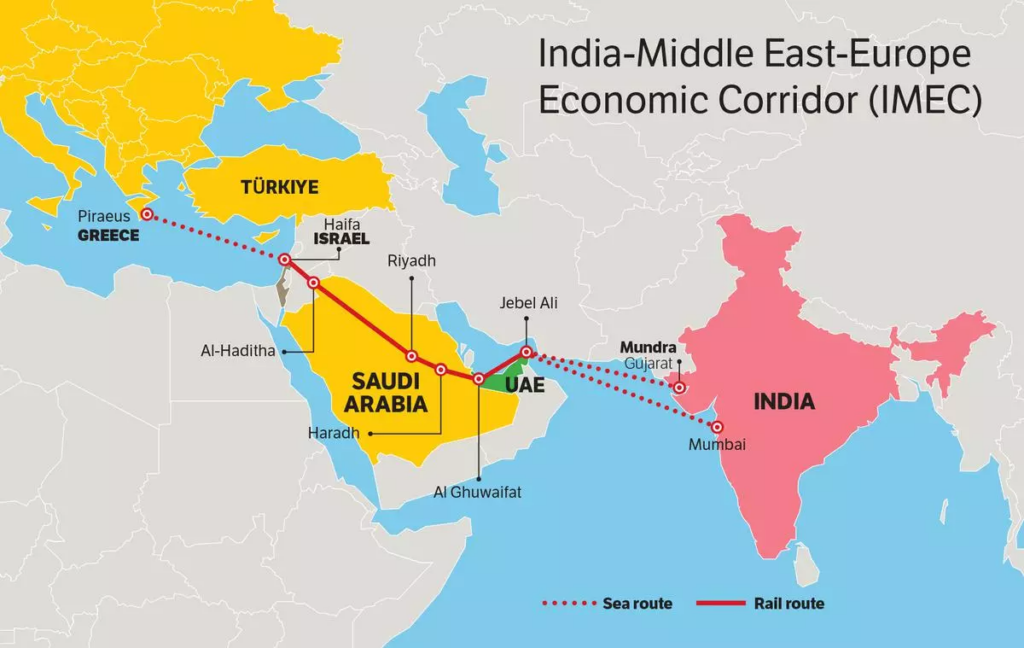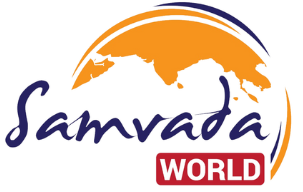
- The Indian Ocean is of immense strategic, economic, and geopolitical importance, not just for India but for the world.
- India views the Indian Ocean as vital for its national security, as it serves as a lifeline for energy imports, trade routes, and naval dominance.
- The IMEC is poised to serve as a strategic alternative to traditional routes like the Suez Canal, especially in light of recent geopolitical challenges affecting global trade.
- The Indian Ocean is not just a regional asset but a global commons that underpins the world economy and strategic stability, and conferences like the IOC are an important platform for India to push its national interests.
Amid the euphoria of the recently concluded meeting between Indian Prime Minister Narendra Modi and US President Donald Trump, an important event went unnoticed and that event was the Indian Ocean Conference (IOC) which was held in Oman. This was the eighth edition and the IOC was started by the India Foundation in 2016 in Singapore, with participation from 30 countries[1].
It is a significant platform for dialogue on geopolitical, economic, and security challenges in the Indian Ocean region. India, as a prominent maritime power and a key player in the region, often emphasizes its strategic priorities, including national security, maritime cooperation, and regional stability.
Though the development of the IOC is not directly tied to the India-Middle East-Europe Economic Corridor (IMEC), the two initiatives are connected in terms of broader goals, such as fostering regional cooperation, connectivity, and geopolitical influence[2]. The IOC primarily focuses on fostering dialogue and collaboration among Indian Ocean region countries, with an emphasis on security, trade, maritime cooperation, and development.
Launched during the 2023 G20 Summit in New Delhi, the IMEC is a collaborative effort among India, the Middle East, and Europe to establish a robust trade corridor. This initiative seeks to enhance connectivity through an integrated network of railways, ports, and undersea cables, facilitating efficient transportation of goods and energy resources. The IMEC is poised to serve as a strategic alternative to traditional routes like the Suez Canal, especially in light of recent geopolitical challenges affecting global trade.
Key Points Connecting the Themes:
- India’s National Security and the Indian Ocean:
India views the Indian Ocean as vital for its national security, as it serves as a lifeline for energy imports, trade routes, and naval dominance. The security of sea lanes of communication (SLOCs) in the Indian Ocean is critical for India’s economic and energy security.
- Maritime Power:
India is enhancing its maritime capabilities through naval modernization, establishing strategic bases, and increasing its presence in chokepoints like the Strait of Malacca. Initiatives like “SAGAR” (Security and Growth for All in the Region) underline India’s commitment to being a net security provider in the region.
- Arab World and the Indian Ocean:
The Arab world, particularly Gulf nations, shares deep economic and energy ties with India. The Indian Ocean serves as the primary conduit for oil and gas exports from the Middle East to India and other regions. Enhancing maritime security and addressing challenges like piracy, terrorism, and illegal fishing are mutual concerns between India and the Arab world.
- Strategic Challenges:
China’s growing influence in the Indian Ocean through the Belt and Road Initiative (BRI) and its “String of Pearls” strategy is a challenge for India. Partnerships with like-minded countries in the region, including Arab nations, can help India counterbalance external influences and maintain regional stability.
- Indian Ocean Conference:
The IOC often serves as a platform for India to discuss its vision of a free, open, and inclusive Indo-Pacific. It brings together key stakeholders, including countries from the Arab world, to promote regional cooperation in areas like maritime security, trade, and sustainability. The IMEC, on the other hand, is a specific infrastructure and economic connectivity project aimed at linking India, the Middle East, and Europe via a network of railways, ports, and digital connectivity.
Further, the conference brings together key regional players, which may include nations involved in the IMEC and through discussions on trade and connectivity, the IOC aligns with India’s broader vision of regional and inter-regional connectivity. This will ensure safe and open sea lanes is critical for the success of projects like the IMEC, and the IOC often addresses maritime security concerns.

Importance of the Indian Ocean for India
Over 90% of India’s trade by volume and nearly 80% by value is carried by sea, with much of it transiting the Indian Ocean. India’s energy security depends on the safe passage of oil imports from the Middle East. India’s geographic location places it at the heart of the Indian Ocean, giving it a natural advantage in monitoring and securing vital maritime trade routes. India’s “island territories” (e.g., Andaman & Nicobar Islands and Lakshadweep) enhance its ability to project power across the ocean. India seeks to expand its blue economy initiatives, leveraging ocean resources for fisheries, offshore energy, and undersea mining.
The Expanding Role of the Indian Navy
The Indian Navy plays a crucial role in safeguarding India’s interests and asserting its presence in the Indian Ocean. Its role has expanded from coastal defence to regional and global power projection. China’s growing influence in the Indian Ocean through its ‘String of Pearls’ strategy has prompted India to increase its naval capabilities. The Indian Navy regularly conducts surveillance in strategic areas such as the Malacca Strait and the South China Sea. Safeguarding Sea Lanes of Communication (SLOCs) and ensuring free navigation and safe trade routes in the Indian Ocean is a top priority, given India’s dependence on maritime trade.
Regional Leadership and Partnerships
India has positioned itself as a “net security provider” in the Indian Ocean Region by conducting joint naval exercises (e.g., the Malabar Exercise with the U.S., Japan, and Australia). Extending humanitarian and disaster relief operations to neighbouring countries (e.g., during cyclones, tsunamis, or oil spills). Collaborating with Indian Ocean littoral states through platforms like the Indian Ocean Rim Association (IORA) and the Quad.
Naval Modernization
The Indian Navy is modernizing its fleet with Aircraft carriers: INS Vikrant (India’s first indigenously built aircraft carrier) and INS Vikramaditya. Submarines: Nuclear-powered submarines like INS Arihant and the expansion of conventional submarine fleets. Recently Indian Navy commissioned new destroyers with Indigenous stealth technology and has frigates, and advanced corvettes that patrol our high seas[3].
Maritime Diplomacy and Anti-Piracy and Counterterrorism
India uses its navy for soft power by conducting port visits, providing training, and engaging in joint exercises with smaller nations in the IOR. Operations like Mission Sagar (providing COVID-19 assistance to Indian Ocean countries) underline India’s growing focus on maritime diplomacy. The Indian Navy actively participates in anti-piracy operations off the coast of Somalia and provides escorts to merchant ships in high-risk areas.

Major Port Development Projects
- Vadhavan Port in Maharashtra: Initiated in August 2024, this deep-sea port is designed to accommodate ultra-large container vessels, positioning India as a pivotal player in global maritime trade.
- International Container Transshipment Port at Galathea Bay, Great Nicobar Island: Scheduled for completion in 2028, this port aims to capture transhipment cargo from the eastern coast of India, as well as neighbouring countries like Bangladesh and Myanmar.
- Vizhinjam International Seaport in Kerala: Strategically located near key international shipping routes, this deep-water port commenced trial operations in July 2024, with full operations expected soon. The Adani Group has committed an additional $1.2 billion to expand its capacity to 3 million TEUs by 2028.
Conclusion
During Modi’s visit to France, he said, “The IMEC is vital for bilateral interests, enhancing strategic supply chains and boosting security in economic, energy, and health sectors across India, Europe, and the Middle East”. Later, when he returned to Washington Trump said, “We agreed to work together to help build one of the greatest trade routes in all of history. It will run from India to Israel to Italy and onward to the United States connecting our partners by ports, railways and undersea cables. Many many undersea cables.”
The Indian Ocean is of immense strategic, economic, and geopolitical importance, not just for India but for the world. The Indian Ocean is home to some of the world’s most critical shipping lanes, such as the Strait of Malacca, the Strait of Hormuz, and the Bab-el-Mandeb. These chokepoints are vital for the global flow of trade and energy. Over 80% of the world’s maritime oil trade passes through the Indian Ocean. The Indian Ocean is surrounded by key players: South Asia, Southeast Asia, the Middle East, and Africa. This makes it a contested space for global powers like the U.S., China, and India[4].
The Indian Ocean is not just a regional asset but a global commons that underpins the world economy and strategic stability and conferences like the IOC are an important platform for India to push its national interests. Also, for India, it is a natural theatre for asserting its influence, securing its interests, and countering external threats. The Indian Navy’s expanding role—from maritime security to regional leadership—is pivotal in ensuring that the Indian Ocean remains a space of cooperation, stability, and sustainable growth.
References:
- [1] https://indiafoundation.in/if_events/8th-indian-ocean-conference-2025/#:~:text=Rajaratnam%20School%20of%20International%20Studies,2025%2C%20in%20Muscat%2C%20Oman
- [2] https://www.financialexpress.com/policy/economy-renewed-push-for-india-middle-east-europe-economic-corridor-3749788/
- [3] https://apnews.com/article/india-navy-submarine-warships-launch-69c138048bb4202a1a409b0b2353a2f4
- [4] https://www.reuters.com/world/india/indias-defence-minister-cites-power-rivalry-indian-ocean-region-2025-01-15/?utm_source=chatgpt.com
Balaji is a freelance writer with an MA in History and Political science and has published articles on defence and strategic affairs and book reviews. He tweets @LaxmanShriram78. Views expressed are the author’s own.
